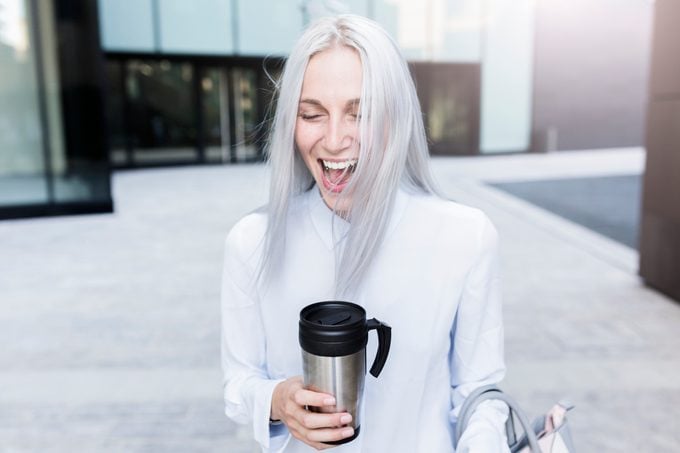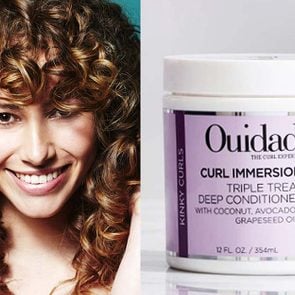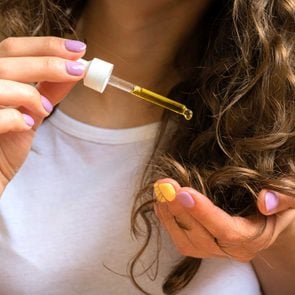How to Transition to Gray Hair, with Self-Assurance: “I Tried It” (Plus, Dermatologist and Stylist Tips)
Updated: Jul. 05, 2022
Dying my hair gray made me feel happier, more confident...and, yes, more beautiful.

Thank social media for putting the spotlight on the “gray to gorgeous” movement that’s empowering women to liberate ourselves from plucking, dying, or otherwise fighting nature’s graceful process that is going gray. “People, especially women, have been conditioned to think that gray hair equals ‘old,’ and only ‘youth’ is beauty—but this couldn’t be farther from the truth,” says David E. Bank, MD, a dermatologist and assistant clinical professor of Dermatology at Columbia Presbyterian Medical Center. Your hair is genetically programmed to grow at a certain color at a certain time, he says, and embracing that can help you feel more confident.
When salons shut down during the pandemic, many women had no choice but to rethink their relationship with their grays. Letting nature “take its course” may be more economical and less time-consuming…but, considering the point Dr. Bank makes about pressures from society and even the people in our lives, it’s no wonder many people don’t love the growing-out process. Devin Giannoni, a Hollywood stylist and founder of Pretty Public Beauty (who is certified in Botantical Body Care by the New York Institute of Aromatic Studies and holds a certificate in plant-based nutrition from the T. Colin Campbell Center for Nutrition Studies at eCornell) suggests there can be a graceful a middle ground: dying your hair in a way that allows you to gradually transition to gray. “The trick is to enhance what you were born with, while not fighting the gray,” Gianonni says. “Constantly dying it darker actually will age you and look artificial.”
She suggests finding a stylist who specializes in gray transitions and requesting a color that is close to your base. Then, your stylist might work in some dimension and depth with gentle highlights to blend out sharp differences in color. “Many women fear gray hair makes them look less attractive, but the opposite is true,” she says. “Embracing it will make your skin look vibrant, your eyes look brighter, and you’ll get plenty of compliments,” Gianonni says.
Jennifer Riggs Anderson, 47, of Gilbert, AZ, spoke with The Healthy to share her journey of going gray on her terms—and her chosen timeline—while facing down expectations from the public and the people she loves.
Focusing on what matters most these days? Read 6 Ways Heart Disease Is Different for Women, Cardiology Experts Say
—
By Jennifer Riggs Anderson, as told to Charlotte Hilton Andersen
“I dyed my hair for 24 years straight. I’m in my forties now. Yep, do the math: I started going gray in my early twenties.
It may have been a simple decision, but it definitely wasn’t a simple thing to do—or to keep up over the years. I’m a natural brunette, and I dyed it blond. This is an even more complicated and expensive process because I had to bleach my hair before dying it. Considering how much time, money, and effort goes into maintaining dyed hair, it’s safe to say I spent thousands of dollars, and more hours than I care to count, in a salon chair.
Then, five years ago, I decided I was done. By that point, my natural hair was close to 100 percent gray, which meant that with color, I needed constant root touch-ups. I was beyond tired of having to return to the salon every three weeks, and there were so many other things I wanted to spend that money on. Plus, I’m a mom of three kids—who has time for all that?
Going gray is a process, not an event
I started by letting my hair grow out naturally for a few months, but the stark difference between the dyed hair and my gray hair bothered me. So I went to a stylist and asked her to dye my hair to match my natural gray. To make the transition smoother, she took me to full gray, and then added a few highlights and lowlights of blonde and brown. The outcome was an ashy gray that she and I both thought was gorgeous.
Best of all, I could go three months before I really even noticed that maybe it was time for another appointment. Then, I realized: Wait—if I can go three months, why not go six months? That’s when I told my stylist I was committing to full gray. She gently transitioned me from the highlighted, ashy gray to my natural gray, with streaks of light brown and white.
I was receiving lots of compliments from strangers, and support from friends…but only one family member approved. My female relatives all had said that gray hair would make me look 10 years older. Some of the women in my family had sworn that they themselves would dye their own hair until the day they died. That idea? It gave me anxiety.
Would you love to rock a more natural look with confidence? Give any of these tips a go.
My hair caused an identity crisis
So a couple of years ago, when we were planning a large family reunion, I relented. I went blond again. I got a lot of compliments from my family…but inside, I was so mad at myself for caving to the pressure. Bringing back my former look made me feel old and outdated. I wasn’t a blonde anymore! Sure, I looked great when I was blond…but it felt fake. For all the years I’d done it, it had never really been me.
After a year, I decided to repeat the process of going gray again. This time, I found several groups on social media that supported going gray. I also read articles about how other women had made the transition, which helped immensely to to make me feel less alone in my decision. My hair is a short bob length, so it took about 15 months to grow all the blonde dye out. I hated how long it took…but now that it’s gone, I’m in love with my hair.
I thought I was committed to my gray hair the first time around but the family reunion experience really helped me see how important this issue is to me. My hair color is part of my core self worth and personal identity. This is me—not in spite of my grays, but because of them. Whether anyone else approves or not, says more about them than me. I’m ready to stay this way forever.
Here are ways to remind yourself that you’re already amazing.
Totally gray and proud of it
I’ve learned that going gray is like anything important in life: you have to decide what is best for you, and then stick with your gut decision. There will be supporters. There will also be naysayers, who are loud and in your face with their opinions. It’s annoying, but it’s better than having to rush to the salon every time I spot a white hair coming through.
At the end of the day, I feel great about going gray. It takes less time and money and I feel like myself. I feel beautiful! Oh, and my family members have finally stopped bugging me about it. Once they realized I was really serious, they got bored and moved on.
My advice? Be strong. Be yourself. Be…bottle-free.”
Sign up for The Healthy newsletter for uplifting wellness wisdom and what’s buzzing in beauty, and follow us on Facebook and Instagram. Keep reading:
- The 10 Best Health Books of 2022: Therapists and Readers Rate the Bestselling Wellness Books So Far This Year
- Doctors Discuss Alopecia and 9 Other Scalp Conditions That Call for Greater Awareness
- Yes, “Face Yoga” Might Actually Make Your Skin Smoother, a Dermatologist and Plastic Surgeon Reveal
- The 12 Vitamin K-Richest Foods for Healthy Aging, from a Nutritional Biochemist
- How Safe Is Your Produce? Authorities List the 12 Dirtiest—and 15 Cleanest—Fresh Groceries for 2022

















